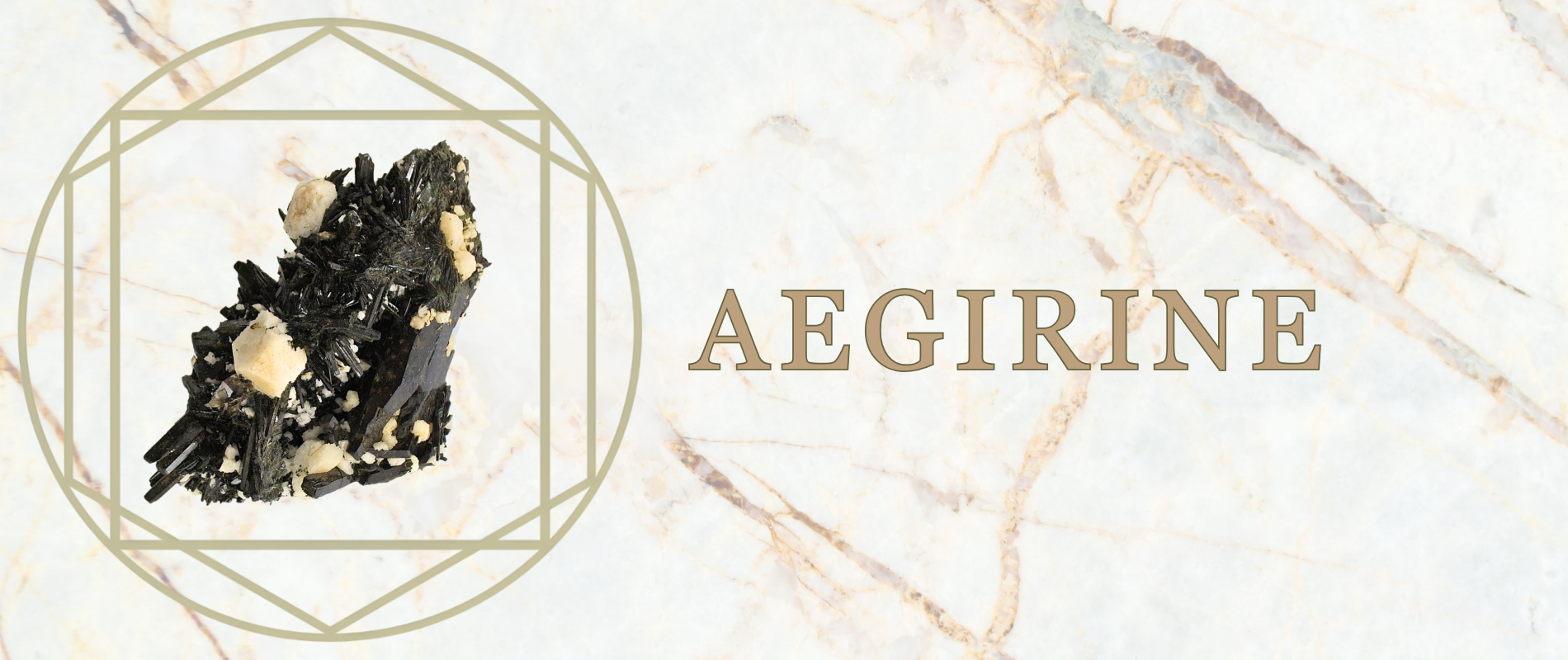
Geology/History
Aegirine is a sodium iron silicate mineral belonging to the pyroxene group, known for its striking slender, prismatic crystals that range in colour from deep green to black. It commonly forms in alkaline igneous rocks such as nepheline syenites, agpaitic pegmatites and carbonatites, as well as in high-alkalinity metamorphic rocks. Aegirine frequently occurs alongside minerals such as feldspar, nepheline, arfvedsonite, riebeckite and eudialyte. Prominent localities include the Kola Peninsula in Russia, Mont Saint-Hilaire in Canada, the Ilímaussaq complex in Greenland, and Mount Malosa in Malawi.
The name ‘Aegirine’ was given in 1821 after Ægir, the Norse god of the sea, reflecting the mineral’s deep sea-green to black hues. The mineral’s name is pronounced “EE-juh-reen” or “EE-guh-reen.” It has been extensively studied for its presence in rare alkaline geological environments. Aegirine is valued by mineral collectors for its rare occurrence and distinctive, elongated crystals. Variations in colour and inclusions of associated minerals such as astrophyllite and eudialyte add to its appeal. The mineral’s complex iron content contributes to its dark colour and magnetic properties. It serves as an important indicator of alkaline magmatic processes and the evolution of highly differentiated igneous and metamorphic systems.
Though not commonly used industrially, Aegirine has attracted scientific interest for its multiferroic properties, exhibiting ferroelectricity in a magnetically ordered state at very low temperatures. Its durability and hardness make it suitable for mineralogical study and occasional ornamental use.
Metaphysical Properties
Aegirine is regarded as a potent stone for protection, energetic integrity and personal empowerment. It is said to anchor the aura firmly within the body, clearing negative influences and shielding against intrusive forces, both emotional and psychic. Widely used for spiritual safeguarding, Aegirine is believed to be especially effective in dispelling curses, hexes and the evil eye, acting as a guardian that strengthens the auric field. Associated with the element of fire and the planet Mars, it is thought to awaken courage, resolve and the inner strength needed to confront adversity. By stimulating the root and sacral chakras, Aegirine is said to support vitality, encourage emotional release and assist in the dissolution of harmful behavioural patterns or lingering attachments. Often described as a stone of clarity and transformation, it is believed to aid in shadow work by bringing hidden or suppressed aspects of the self into conscious awareness. Aegirine is thought to foster self-acceptance, insight and a clearer perception of spiritual truth.
Some practitioners also use Aegirine for protection against environmental disturbances such as electromagnetic fields, believing it encourages energetic balance in spaces affected by modern technology. Through its grounding yet stimulating qualities, Aegirine is said to reinforce the alignment between body, will and spirit, promoting resilience, integrity and inner sovereignty.
Crystal Healing
Supports physical vitality and endurance, enhances circulation and detoxification, and aids in overcoming fatigue. Calms nervous tension and promotes emotional release, facilitating the breaking of negative behavioural cycles. Encourages mental clarity, focus and spiritual insight, promoting resilience and confidence.
Mineralogy
Group: Pyroxene
Crystal System: Monoclinic
Chemical Composition: NaFe³⁺Si₂O₆ (Sodium Iron(III) Silicate)
Form/Habit: Prismatic, elongated slender crystals, often striated longitudinally
Hardness: 5 to 6
Cleavage: Distinct but not perfect, Two directions at approximately 87° and 93°
Fracture: Uneven to conchoidal
Lustre: Vitreous to slightly resinous
Streak: Pale greenish-grey to grey-white
Specific Gravity: 3.5 – 3.6
Transparency: Transparent to translucent
Refractive Index (R.I.): nα = 1.720 – 1.740, nβ = 1.740 – 1.760, nγ = 1.765 – 1.800 (main refractive index range)
Birefringence: 0.045 – 0.060
Colour: Dark green to black, sometimes brownish or reddish-brown due to iron content
Pleochroism: Strong, typically green to yellowish-green or brown tones
Fluorescence: None
Strunz Classification: 9.DA.30 (Inosilicates, single chain pyroxenes)
Dana Classification: 66.1.2.1 (Inosilicates)